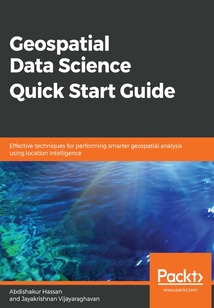舉報 

會員
Geospatial Data Science Quick Start Guide
Datascientists,whohaveaccesstovastdatastreams,areabitmyopicwhenitcomestointrinsicandextrinsiclocation-baseddataandaremissingoutontheintelligenceitcanprovidetotheirmodels.Thisbookdemonstrateseffectivetechniquesforusingthepowerofdatascienceandgeospatialintelligencetobuildeffective,intelligentdatamodelsthatmakeuseoflocation-baseddatatogiveusefulpredictionsandanalyses.Thisbookbeginswithaquickoverviewofthefundamentalsoflocation-baseddataandhowtechniquessuchasExploratoryDataAnalysiscanbeappliedtoit.Wethendelveintospatialoperationssuchascomputingdistances,areas,extents,centroids,bufferpolygons,intersectinggeometries,geocoding,andmore,whichaddsadditionalcontexttolocationdata.Movingahead,youwilllearnhowtoquicklybuildanddeployageo-fencingsystemusingPython.Lastly,youwilllearnhowtoleveragegeospatialanalysistechniquesinpopularrecommendationsystemssuchascollaborativefilteringandlocation-basedrecommendations,andmore.Bytheendofthebook,youwillbearockstarwhenitcomestoperforminggeospatialanalysiswithease.
目錄(136章)
倒序
- coverpage
- Title Page
- Copyright and Credits
- Geospatial Data Science Quick Start Guide
- Dedication
- About Packt
- Why subscribe?
- Packt.com
- Contributors
- About the authors
- About the reviewers
- Packt is searching for authors like you
- Preface
- Who this book is for
- What this book covers
- To get the most out of this book
- Download the example code files
- Download the color images
- Conventions used
- Get in touch
- Reviews
- Introducing Location Intelligence
- Location data
- Understanding location data from various perspectives
- From a business perspective
- From a technical perspective
- From a data perspective
- Types of location data
- Location data intelligence
- Application of location data intelligence
- User or customer perspective
- Venue or business perspective
- Location data science versus data science
- Data science
- Location (spatial) data science
- A primer on Google Colaboratory and Jupyter Notebooks
- Summary
- Consuming Location Data Like a Data Scientist
- Exploratory data analysis
- Handling missing values
- Handling time values
- Time values as a feature
- Handling unrelated data
- Spatial data processing
- Taxi zones in New York
- Visualization of taxi zones
- Spatial joins
- Calculating distances
- Haversine distance
- Manhattan distance
- Error metric
- Interpreting errors
- Building the model
- Validation data and error metrics
- Summary
- Performing Spatial Operations Like a Pro
- GeoDataFrames and geometries
- Geographic coordinates and geometries
- Accessing the data
- Geometry
- Coordinate reference systems
- GeoDataFrames
- Spatial operations
- Projections
- Buffer analysis
- Spatial joins
- Location data visualization
- Summary
- Making Sense of Humongous Location Datasets
- K-means clustering
- The crime dataset
- Cleaning data
- Converting into a GeoDataFrame
- K-means clustering with scikit-learn
- Density-Based Spatial Clustering Applications with Noise
- Detecting outliers
- Detecting clusters
- Spatial autocorrelation
- Points in a polygon
- Global spatial autocorrelation
- The choropleth map
- Spatial similarity and spatial weights
- Global spatial autocorrelation
- Local spatial autocorrelation
- Summary
- Nudging Check-Ins with Geofences
- Geofencing
- Geofencing applications
- Marketing and geofencing
- Geometry and topology (lines and polygons)
- Line geometries
- Polygon geometries
- Topology – points in a polygon
- Geofencing with Plotly
- Masking
- Plotly interactive maps
- Summary
- Let's Build a Routing Engine
- Fundamentals of graph data structure
- Directional graphs
- Weighted graphs
- Shortest path analysis on a simple graph
- Dijkstra's algorithm
- Calculating Dijkstra's shortest path
- Calculating Dijkstra shortest path length
- Calculating single source Dijkstra path length
- Turning a simple DataFrame into graphs
- Building a graph based on a road network
- Open Street Maps data
- Exploring the road data
- Creating a graph from a DataFrame
- Reading and exploding the geometry
- Calculating the distance of edges
- Finding a proxy for maximum speed
- Accounting for directionality
- Calculating drivetime
- Building the graph
- Shortest path analyses on the road network graph
- Dijkstra's shortest path analysis
- Dijkstra's shortest path cost
- Single source Dijkstra's shortest path cost
- Concept of isochrones
- Constructing an isochrone
- Summary
- Getting Location Recommender Systems
- Exploratory data analysis
- Rating data
- Restaurants data
- Recommender systems
- KNNWithMeans
- SVDpp
- Comparison and interpretations
- Location-based recommenders
- Summary
- Other Books You May Enjoy
- Leave a review - let other readers know what you think 更新時間:2021-06-24 13:48:39
推薦閱讀
- 21天學(xué)通PHP
- Getting Started with Containerization
- 人工智能實踐錄
- 工業(yè)機(jī)器人安裝與調(diào)試
- The Python Workshop
- Microsoft System Center Confi guration Manager
- SAP Business Intelligence Quick Start Guide
- 空間機(jī)械臂建模、規(guī)劃與控制
- 啊哈C!思考快你一步
- 單片機(jī)技能與實訓(xùn)
- Mastering Exploratory Analysis with pandas
- 簡明學(xué)中文版Photoshop
- 手把手教你學(xué)Flash CS3
- 從祖先到算法:加速進(jìn)化的人類文化
- iLike就業(yè)SQL多功能教材
- 仿蛛機(jī)器人的設(shè)計與制作
- 計算機(jī)導(dǎo)論:實訓(xùn)篇(第2版)
- 樂高機(jī)器人:Scratch與WeDo編程基礎(chǔ)實戰(zhàn)應(yīng)用
- 大學(xué)計算機(jī)實踐教程
- 智能移動機(jī)器人的設(shè)計、制作與應(yīng)用
- IBM Watson Projects
- Android High Performance Programming
- 筆記本電腦維修實用教程
- ROBOTC FOR LEGO EV3基礎(chǔ)編程與實例
- R Graph Essentials
- Fedora 31 Essentials
- 存儲技術(shù)原理分析
- UG NX 8.0中文版從入門到精通
- Mastering PostgreSQL 12
- 看圖學(xué)中文版Word 2007

